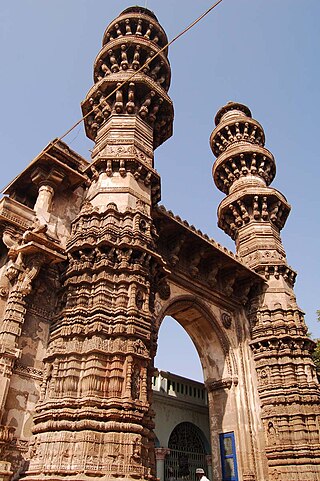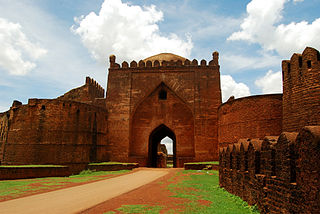This article needs additional citations for verification .(July 2013) |
| |||||
| Centuries: | |||||
|---|---|---|---|---|---|
| Decades: | |||||
| See also: | List of years in India Timeline of Indian history | ||||
Events from the year 1511 in India.
This article needs additional citations for verification .(July 2013) |
| |||||
| Centuries: | |||||
|---|---|---|---|---|---|
| Decades: | |||||
| See also: | List of years in India Timeline of Indian history | ||||
Events from the year 1511 in India.

Year 1511 (MDXI) was a common year starting on Wednesday of the Julian calendar.
Mahmud Shah may refer to:

The Deccan sultanates were five late-medieval Indian kingdoms—on the Deccan Plateau between the Krishna River and the Vindhya Range—that were ruled by Muslim dynasties: namely Ahmadnagar, Berar, Bidar, Bijapur, and Golconda. The sultanates had become independent during the break-up of the Bahmani Sultanate. The five sultanates owed their existence to the declaration of independence of Ahmadnagar in 1490, followed by Bijapur and Berar in the same year. Golconda became independent in 1518, and Bidar in 1528.
Sultan Mahmud Begada or Mahmud Shah I was the most prominent Sultan of the Gujarat Sultanate. Raised to the throne at young age, he successfully captured Pavagadh and Junagadh forts in battles which gave him his name Begada. He established Champaner as the capital.
Champaner is a historical city in the state of Gujarat, in western India. It is located in Panchmahal district, 47 kilometres from the city of Vadodara. The city was briefly the capital of the Sultanate of Gujarat.At an early period Chámpáner was the seat of a Bhil dynasty. Champaner was founded by King Champa Bhil.

Sidi Bashir Mosque is a former mosque in the city of Ahmedabad, Gujarat, India. Only the central gateway and two minarets survive; they are known as the Jhulta Minar or Shaking Minarets.

The Gujarat Sultanate, or the Sultanate of Guzerat, was a late medieval Indian kingdom established in the early 15th century in Western India, primarily in the present-day state of Gujarat, India. The kingdom was founded by Muzaffar Shah I who was appointed as Tughlaq governor of Gujarat after the death of his father in 1371. Following Timur's invasion of the Delhi Sultanate, Delhi was devastated and its rule weakened considerably, so he declared himself independent in 1394, and formally established the Sultanate. The next sultan, his grandson Ahmad Shah I moved the capital to Ahmedabad in 1411. His successor Muhammad Shah II subdued most Rajput chieftains. The prosperity of the sultanate reached its zenith during the rule of Mahmud Begada. He also subdued most Gujarati Rajput chieftains and built a navy off the coast of Diu. In 1509, the Portuguese empire wrested Diu from the Sultanate in the Battle of Diu (1509). The Mughal emperor Humayun attacked Gujarat in 1535 and briefly occupied it, during which Bombay, Bassein & Daman would become a Portuguese colony, thereafter Bahadur Shah was killed by the Portuguese while making a deal in 1537. The end of the sultanate came in 1573, when Akbar annexed Sultanate of Guzerat into his empire. The last ruler Muzaffar Shah III was taken a prisoner to Agra. In 1583, he escaped from the prison and with the help of the nobles succeeded to regain the throne for a short period before being defeated by Akbar's minister Abdul Rahim Khan-i-Khanan.
The Farooqi dynasty was the ruling dynasty of the Khandesh Sultanate from its inception in 1382 till its annexation by the Mughal emperor Akbar in 1601. The founder of the dynasty, Malik Ahmad participated in a rebellion against the Bahmani ruler Muhmmad Shah I in his early years. When he was compelled to flee from Deccan, he established in Thalner on the Tapti River. After receiving the grant of the fiefdoms of Thalner and Karanda from Firuz Shah Tughluq in 1370, he conquered the region around Thalner, which later became known as Khandesh. By 1382, he started ruling independently.

Sarkhej Roza is a mosque and tomb complex located in the village of Makarba, 7 km south-west of Ahmedabad in Gujarat state, India.
Events from the year 1534 in India.
Events from the year 1558 in India.

Paranda Fort is situated in Paranda, a small town in the Osmanabad district in the state of Maharashtra, India. It is protected monument by the Archaeological Survey Of India. The fort may have been constructed in the 15th century by Mahmud Gawan or by Murtaza Nizam Shah II in the early 1600s. Paranda has great historical value and finde mention in Honnati inscription of Baka 1045 and also later a few of the Kalyan Chalukyan an copper plates. As well as in Yadava epigraphs, as Pallyanda Pratyandaka. The fort is attraction in this Paranda town and is known to have been built by Mahmud Gavan, the Prime Ministar of Muhammad Shah Bahmani 2.

Deccani Architecture refers to the architectural styles developed during the Deccan sultanate period. The Deccan sultanates were five dynasties that ruled late medieval kingdoms, namely, Bijapur, Golkonda, Ahmadnagar, Bidar, and Berar in south-western India. The Deccan sultanates were located on the Deccan Plateau. Their architecture was a regional variant of Indo-Islamic architecture, heavily influenced by the styles of the Delhi Sultanate and later Mughal architecture, but sometimes also directly from Persia and Central Asia.
Mahmood Shah or Shihab-Ud-Din Mahmud was the sultan of the Bahmani Sultanate from 1482 until his death in 1518. His long rule is noted for the disintegration of the sultanate and the creation of the independent Deccan sultanates.
Malik Ahmad Nizam Shah was the founder of the Nizam Shahi dynasty and the Ahmadnagar Sultanate.
Amran, formerly known as Amran is a village in morbi Taluka of morbi district of Gujarat, India.
Muizz-ud-Din Muhammad Shah II, born Karim Khan, was a ruler of the Muzaffarid dynasty, who reigned over the Gujarat Sultanate from 1442 to 1451. He expanded and strengthened the Sultanate.
Mandalika III, called by the epithet Ra Gangajalio, was a Chudasama king of Saurashtra region of western India who reigned from 1451 CE to 1472 CE. His capital was at Junagadh.
Daud Shah, born Daud Khan, was a ruler of the Muzaffarid dynasty, who reigned over the Gujarat Sultanate from few days in 1458.